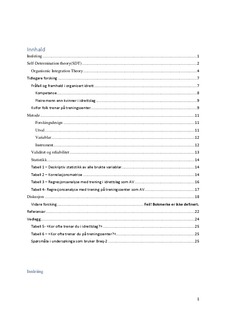| dc.contributor.advisor | Mehus, Ingar | |
| dc.contributor.author | Glomnes, Iver Matias Linge | |
| dc.date.accessioned | 2019-09-06T14:12:35Z | |
| dc.date.available | 2019-09-06T14:12:35Z | |
| dc.date.issued | 2019 | |
| dc.identifier.uri | http://hdl.handle.net/11250/2613710 | |
| dc.description.abstract | Denne studien undersøker samanhengen mellom motivasjon for å trene og kva for arena ein vel å trene på av treningssenter eller i idrettslag. Målet var å finne ut kva som kjenneteiknar dei som held fram å trene i idrettslag i ein alder der dei fleste har falle frå, kontra dei som i staden vel å trene på treningssenter. Det teoretiske rammeverket er Ryan og Deci(1985,2000) sin «Self-Determination theory»(SDT) med hovudfokus på underteorien «Organismic integration theory»(OIT).
Studien nyttar kvantitativ metode der datamaterialet er henta frå ei spørjeundersøking gjort på SIT treningssenter(som er treningssenter for studentar) i 2018(N=696), og spørsmåla om motivasjon i denne undersøkinga er henta frå Breq-2(utarbeida av Markland and Tobin 2004), som måler dei ulike motivasjonstypane i OIT.
Resultata frå studien viser at både dei som trenar i idrettslag og dei som trenar på treningssenter har ein sjølvbestemt motivasjon for trening. Hovudforskjellen er at dei som har indre motivasjon for å trene, trenar meir i idrettslag, medan dei som trenar for å nå instrumentale mål, trenar meir på treningssenter. Litteraturen viser støtte for dette ved at dei vanlegaste grunnane til å slutte i idrettslag er at ein manglar indre motivasjon, medan dei vanlegaste grunnane til å trene på treningssenter er for å oppnå instrumentale mål som ligg utanfor sjølve aktiviteten. | |
| dc.description.abstract | The study investigates the differences in the motivation for training among people who chooses to exercise in respectively organized sports teams and in the gyms. The goal was to examine what characterizes those who choose to continue in organized sports in an age where most people have quitted, versus those who instead chooses to train in the gyms. The study uses the theoretical framework of Deci and Ryan`s(1985,2000) “Self-determination theory”(SDT), with main focus on the sub theory “organic integration theory”(OIT).
The study uses a quantitative method where the data material is retrieved from a survey competed in SIT(which are for students) in 2018(N=696). The questions for motivation in this study uses the instrument Breq-2(of Markland and Tobin 2004), which measures the different types of motivation in the OIT.
The results from the study shows that both groups have an autonomous motivation for training. The main differences is that those who have intrinsic motivation for exercise, chooses to exercise more in organized sports, and those who exercises for instrumental goals, exercises more in gyms. The literature supports this by showing that the most common reasons to quit organized sports is lack of intrinsic motivation, and the most common reason to exercise in gyms is to achieve instrumental goals. | |
| dc.language | nno | |
| dc.publisher | NTNU | |
| dc.title | Motivasjon for trening i idrettslag og på treningssenter | |
| dc.type | Bachelor thesis | |
